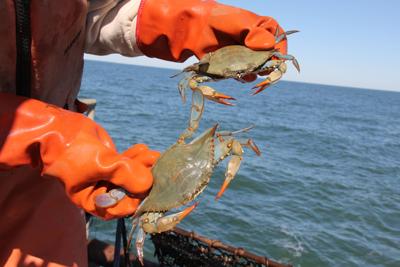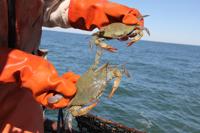CHESAPEAKE BAY, MD - Maryland and Virginia have released the results of the 2025 Chesapeake Bay Blue Crab Winter Dredge Survey, showing decreased but sustainable populations of the crustaceans.
According to the dredge results, the total population of blue crabs in the Chesapeake is estimated at 238 million, down from 2024’s estimated 317 million. Both male and female crab numbers have decreased in abundance, according to the study, and juvenile crab populations were below average for the sixth year in a row.
Officials with the Virginia Marine Resources Commission (VMRC) say the decreases are not surprising, as colder-than-average temperatures throughout the winter can lead to increased mortality in crabs that overwinter in the Bay’s floor. Maryland researchers agreed.
“We saw a very high mortality rate among blue crabs this winter, likely due to several cold snaps,” said Mandy Bromilow, DNR’s blue crab program manager. “With the results of the stock assessment next year, we hope to have more insight on what could be contributing to the ongoing low juvenile recruitment and what we can do to support the Chesapeake Bay’s blue crabs. Until then, we need to maintain caution in our management approach for blue crabs.”
DNR says the survey’s total population estimates are the second lowest in the dredge program’s history, which has been conducted since 1990. 2022 saw the lowest total at 226 million.
According to the survey, the number of female crabs, 108 million, remains above the threshold of 72.5 million but lower of the target number of 196 million. Thresholds are lower numbers that, once hit, can trigger management responses and harvesting restrictions. Female crab populations are the most important factor in maintaining reproductive sustainability, according to VMRC.
“Maintaining adult female abundance above this critical benchmark is a central goal of the Bay jurisdictions' blue crab conservation strategies,” VMRC wrote in a media release Thursday. “The threshold serves as a scientific reference point for avoiding an overfished population and ensuring the long-term viability of the fishery. Managers emphasize that this continued stability in female crab numbers supports cautious optimism, even as overall abundance has declined.”
The Chesapeake Bay Foundation (CBF) did not appear to share that cautious optimism in light of the survey's results. Following the release of the latest population estimates, CBF called on Maryland to strengthen protections for female crabs, Virginia to reduce its crab harvest, and for the federal government to restore funding for NOAA and the EPA.
“The latest blue crab numbers are extremely distressing," CBF Virginia Executive Director Chris Moore said in a statement. "Blue crabs are a staple on our plates, in our water, and in our culture. We must protect them in order ensure their important role in the Chesapeake Bay ecosystem and preserve sustainable harvests for the most valuable commercial fishery in the Bay."
Further assessment of the blue crab populations through an ongoing stock assessment will help determine factors impacting the populations, such as dead zones, water temperature, habitat availability, and predation by blue catfish, DNR says. The results of that assessment are expected in spring of 2026.
VMRC says they will await guidance from the Crab Management Advisory Committee (CMAC) now that the winter dredge results have been released. The CMAC is slated to meet to review the findings at their next meeting on May 29.
The results of the 2025 Chesapeake Bay Blue Crab Winter Dredge can be found here.
The latest winter crab dredge survey results are raising concerns among seafood business owners on Maryland’s Mid-Shore, who fear the troubling numbers could lead to new restrictions on the water.
It's a major disappointment for crab-dependent businesses like Bay Hundred Seafood in St. Michaels.
“Definitely… alarming. We don’t like the numbers. We don’t like to see that trend happening. So, we are concerned, and it seems like they’re coming through because we’re not seeing the crabs to back ’em up,” said Joe Spurry, owner of Bay Hundred Seafood.
Spurry said catches have been noticeably light this season, and he worries more state-imposed regulations could soon follow.
“I mean, they always have a knee-jerk reaction to numbers, and we’ve been under male limits in the last few years, and we’ll probably be there again,” he said. “It’s hard for watermen to be on limits because there’s so many times that they can’t catch their limits — and that’s how watermen, fishermen, make it up: when they are actually on crabs.”
Jack Brooks, owner of J.M. Clayton Seafood Company in Cambridge, shares similar concerns, but says the blame doesn’t lie with the watermen.
“It says to me that we have a lack of habitat — bay grasses, places for them to hide. It seems to be that blue catfish are just doing an enormous amount of damage,” said Brooks.
Despite the bleak numbers, Brooks said a poor winter survey does not always mean a bad harvest is coming.
“The survey is not 100%, but, you know, we’re certainly hopeful. I’ve been here a long time, and weathered lower populations before — and we know we’ll do it again,” he said.



